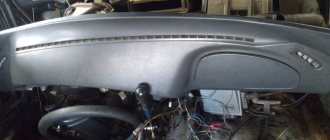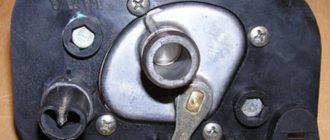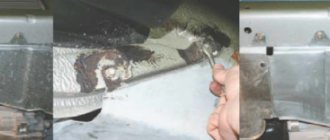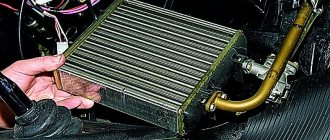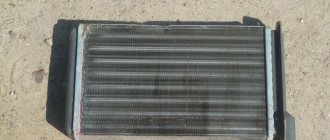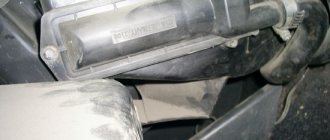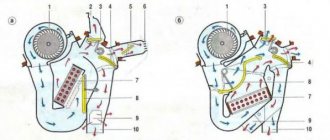The appearance of puddles of coolant in the car’s interior makes the owner wonder where the valve for the VAZ-2115 heater is located. In the vast majority of cases, this unpleasant symptom occurs precisely because of the leakage of this part. To replace a faucet, it is absolutely not necessary to go to a car service center - this procedure is quite simple and does not require any special knowledge or skills.
The heater valve in car 2115 is located at the bottom of the dashboard. You can reach it from the passenger seat. At the same time, to replace a part, you do not have to disassemble half of the machine, since access to it is almost completely open.
What is needed to replace the heater valve on a VAZ-2115 car
If a faucet is leaking, it must be replaced as soon as possible. Otherwise, the coolant can seriously flood the entire cabin. In such a situation, you will not only need to make repairs, but also spend quite a lot of time cleaning the car.
What is needed to replace the stove faucet? You only need a few tools and supplies:
- set of socket and socket wrenches;
- Screwdriver Set;
- new part. It is best to choose modern ceramic taps, which are equipped with all the necessary sealing elements;
- WD-40 liquid;
- silicone sealant ensuring reliable sealing of the system;
- any container into which you will drain coolant.
It is best to carry out car repairs in a pit or using a lift - this way you can get free access to all the parts.
Work algorithm
To change the heater valve on a VAZ 2114 you will need the following tools:
- Pliers,
- Double-sided screwdriver (straight and curved),
- Socket or socket wrenches No. 10 and 13.
However, it is possible to change the faucet of the VAZ-2114 stove yourself and this will require not so many tools and spare parts:
- replacement valve (diaphragm, ceramic or ball);
- new clamps;
- pipes (if those installed on the car have lost their elasticity);
- antifreeze;
- container for collecting coolant;
- wrenches for 10 and 13 (heads with extensions are possible);
- screwdrivers (phillips, flat);
- rags.
For ease of work, you will need an inspection hole or overpass, since during the removal and installation process you will have to climb under the car.
The faucet can be replaced in two ways - with full or partial drainage of antifreeze.
The first option is suitable for those who decide to simultaneously replace the antifreeze. Before starting work, unscrew the drain plugs and wait for the coolant to drain into the container, after which we proceed to remove the assembly.
Replacement with partial drainage is suitable for those who have a supply of antifreeze for refilling. We place a container under the car at the junction of the cooling system pipe with the tap and disconnect this pipe, after which we lift its end up and fix it in this position.
- We place the car on a pit or overpass and wait until the engine cools down (not completely, but so that it remains warm).
- Drain the antifreeze (partially or completely).
- We disconnect the coolant supply and drain from the faucet on the side of the engine compartment.
- In the passenger compartment, remove the side decorative trim of the console on the passenger side.
- We loosen the clamps securing the pipes to the faucet fittings in the cabin and disconnect the pipes, having first placed a rag under them. If you plan to replace the pipes, you can disconnect them from the heater radiator and remove the faucet along with the pipes.
- Disconnect the control mechanism cable from the locking diaphragm axis lever. If it is not possible to separate them from the passenger side, then you can get to them from the driver’s side (after first removing the plastic trim).
- We climb under the car. We find two nuts securing the faucet body to the engine shield and unscrew them and remove the washers from the studs.
- We move into the cabin and remove the unit.
Assembly is performed in the same sequence as dismantling.
The process of replacing the stove valve on a VAZ-2115
First, completely drain the antifreeze into a previously prepared container to avoid leaks during the process of dismantling a leaky faucet.
After completing this procedure, the following steps will be required:
- loosen the clamps securing the pipes that connect the engine to the heater tap;
- We clean the pipes using a metal brush and treat them with WD-40 liquid. This simple step will allow you to unscrew the old part without any problems;
- unscrew the nuts that secure the faucet. To do this you need to use a key of 10;
- We move into the car interior and, slightly pulling the part towards ourselves, remove the special spring retainer;
- disconnect the valve from the control cable and remove it;
- We connect the cable to the new part, install the spring clamp in place and screw the tap to the pipes.
Assembly is carried out in reverse order. When connecting a new faucet, be sure to use silicone sealant that is resistant to coolant, and also screw the drain plug into place. At the last stage, fill in antifreeze and check the operation of the system.
About modernizing the heating tap
As already mentioned, the stove valve on the VAZ is not very reliable. Therefore, some car enthusiasts take radical measures in order to rid themselves of antifreeze leaks once and for all. The simplest modernization option looks like this: an adapter tube is cut out of the tap, and a simple ceramic water fitting with a ball valve is inserted in its place (and car owners prefer to install branded Italian fittings rather than cheap Chinese ones). The resulting design is shown in the photo below.
Car enthusiasts often install ordinary water fittings on their VAZ stove taps.
The advantages of such a replacement are obvious: high reliability and no leaks. But there is also a significant disadvantage: you have to open and close the tap manually. And to do this you will need to stop and climb under the hood every time.
Installing a stove tap directly in the cabin can hardly be called a successful engineering solution, especially if the reliability of the unit is low. So the VAZ owner will definitely have to change the stove valve, and the best thing he can do in this situation is not to wait for the coolant to flow under the passenger’s feet, but to install a ceramic valve immediately after purchasing the car.
- Author: Alexey Stepanov
Copywriter with five years of experience. Rate this article:
- 5
- 4
- 3
- 2
- 1
(8 votes, average: 4.1 out of 5)
Share with your friends!
How to choose the right stove tap
Finally, we would like to give some useful recommendations on choosing a heater tap for your car.
The modern market offers several varieties of these devices:
- The simplest option is a crane installed at the car manufacturer. It is built on a membrane element made of rubber, which often cannot withstand elevated temperatures and “sticks.” The solution to this problem is to replace the product. This is why it is better not to buy factory taps;
- a ball valve, which will cost much more than a membrane valve, but will also last much longer;
- ceramic device. The best option, which is deservedly considered the most reliable and durable. To make the body of such a faucet, a metal or polymer material that is resistant to overheating is used, and a pair of ceramic plates is used as a locking element.
Which faucet to choose for the VAZ-2115 stove? We recommend not saving on purchasing this part and choosing the most durable option. This will avoid frequent replacement and save a very decent amount of money.
Which faucet should I buy?
In auto stores you can see three types of cranes:
- Regular factory
- Ceramic
- Ball.
How are they different? An ordinary factory faucet costs about one hundred rubles. There is a rubber membrane installed inside it.
Such a tap is very unreliable and often turns sour. You should not install it in your car.
The ceramic faucet is the most reliable. That is why it is recommended to install it. The body of this faucet is made of plastic, and the locking elements are made of ceramics.
It is worth considering that the throughput of a ceramic faucet is lower than that of a ball faucet. A ball valve is much more reliable than a regular factory one. Instead of a rubber membrane, a ball with holes is installed in it.
Heating system design
The valve in question allows you to close or, on the contrary, give unlimited access to the engine-heated coolant (coolant) to the heater radiator. To enhance convection, the circuit also uses an electric fan. The latter pumps air, heat exchange occurs, and the temperature in the cabin rises.
The heater tap is located under the dashboard. You can access it by removing the side trim from the front passenger seat.
In the summer, there is no need for a heater, and therefore the damper remains closed, and, accordingly, antifreeze stops flowing into the heater. In this case, the system performs the function of ventilation, and unnecessary coolant circulates through a small circuit and cools in the main radiator.
The tap begins to be actively used in the fall, when the need for a stove arises. It is driven by a special lever mounted on the instrument panel. A drive cable comes from it, which, in turn, is connected to the locking valve mentioned above.
Purpose, location and design of the VAZ 2113–15 stove
Unlike classic Zhiguli models, the VAZ 2113–15 stove copes with its duties quite well. If it is in good working order, the inside of the car will always be warm. The air flow distribution system is also implemented quite well, so the windshield, even in severe frost, is completely cleared of ice in a few minutes.
Purpose of the heater
The main function of the stove is to heat the interior and windshield. Hot air supplied through the duct system to the windshield prevents it from freezing in winter. In the warm season, the stove is used for forced ventilation of the interior.
Location and design of the stove
The VAZ 2113–15 stove is located in the front part of the cabin under the center console of the dashboard. Only the heater controls and deflectors through which air flows are brought into the cabin.
The interior heater of the VAZ 2113–15 is closed by the center console
The stove consists of the following elements:
- casing;
- radiator;
- tap;
- inlet and outlet pipes;
- electric motor with a cylindrical impeller;
- windshield defroster;
- control valve;
- foot air damper;
- control module (mode switch, resistor, damper control levers).
Operating principle of the stove
The operation of the stove is based on heat exchange between the heated coolant (coolant) and the air entering the cabin. The basis of the design is the radiator. It is a system of tubes within which heated coolant supplied from the power unit circulates. The tubes are equipped with thin lamellas, allowing for more efficient heat transfer to the air.
The radiator is covered by a casing, which is the body of the stove. On one side there is an electric fan that pumps air into the device. By varying the fan rotation speed with a switch that changes the resistance of a special resistor and located on the central panel, you can regulate the intensity of the air flow entering the cabin.
Circulating between the radiator lamellas, the air heats up and enters the passenger compartment through air ducts located in the front part of the heater. The distribution of flows is carried out using three dampers, one of which (control) regulates (opens or closes) the flow of air into the cabin, and the other two (air blowing for the legs and windshield) change its direction.
The basis of the design of the interior heater is the radiator
The stove can be completely disconnected from the engine cooling system using a tap that shuts off the coolant supply to the radiator of the heating system.
Causes of failure
Replacing the tap, in the case of a VAZ, is usually required if it stops working. This happens when it gets jammed. This happens due to the sedimentation of solid particles contained in antifreeze and metal corrosion on its elements.
The second reason is the appearance of a leak. It occurs after the membrane loses its tightness.
In both situations there is no choice - you have to start repairing. It is almost impossible to repair the faucet itself - it is simply replaced with a working one. The procedure is not complicated, but it is advisable to carry out all the work together with an assistant.
A leaking stove tap needs to be eliminated as quickly as possible, as it can cause many problems. The leakage of antifreeze directly into the cabin is the most insignificant of them.
More trouble will be caused by a lack of coolant in the engine cooling system - because of this, it can easily fail.
So, if the cabin suddenly smells of antifreeze, and a wet spot appears under the rug, then, first of all, it is the faucet that needs to be checked. Arm yourself with a flashlight and, having removed the side panel from the center console (passenger side), look into the opened niche. Please note that there may be a leak from the radiator, as well as from the pipes, which means it wouldn’t hurt to inspect them. However, more often than not it is the faucet that is to blame.
Causes and symptoms of malfunction
The heater valve breaks for two reasons:
- Locking devices become sour. Because of this, the driver cannot open or close the tap. Oxidation provokes sticking of the locking elements to each other. If you use force, you risk breaking the locking devices. This is not so scary in the warm season, since air flows can be controlled by dampers. How to check the faucets of the VAZ-2114 stove for souring? Just give it a spin. If this requires a lot of force, the element is worn out and needs to be replaced.
- Violation of tightness. Depressurization entails a leak of coolant. Such a breakdown is indicated by a decrease in the coolant level, the appearance of a smell of antifreeze or antifreeze inside the car, the formation of greasy spots on the windshield and traces of coolant on the floor (in the glove compartment area, at the feet of the front passenger). Checking for leaks is easy. If it is broken, you will notice it immediately by characteristic signs.
Important! The stove faucet has a non-separable body. Therefore it is impossible to repair it
If an element breaks, you only need to replace it.
When the warm season arrives, the tap is turned to its extreme position. Being in this state for a long time, it can turn sour, as a result of which it will be very problematic to regulate. If you use force, the crane can be broken. Such a breakdown is not critical - the car will still be drivable.
Works, but leaks
Over time, the O-rings age, causing the faucet to not close completely. The consequences of this may be:
- Lowering the fluid level in the distribution tank. With such a “symptom”, the tap needs to be checked urgently, because the tank also supplies the engine cooling system.
- Wet carpet in the cabin.
To check the faucet for leakage, you need to bend the mat
A grease mark on the bottom of the windshield.
When checking, pay attention to the underwater hoses. Over time they may become thinner
- souring of the locking device;
- depressurization of the housing (leaking).
In the first case, it turns out to be impossible to open or close the tap. Oxidative processes inside lead to the elements of the locking mechanism sticking to each other.
Using force to remove constipation can lead to its complete destruction. This breakdown is not critical, and allows you to operate the car in the warm season. It is enough to simply block the flow of air into the cabin using a damper.
- decrease in coolant level;
- presence of a characteristic odor in the cabin;
- the appearance of a greasy coating on the windshield;
- traces of coolant on rubber mats or carpet under the glove compartment.
It is worth noting that the heater valve has a non-separable body, which is why it cannot be repaired. Only replacing it will help here.
There are three faults in the valve of the VAZ-2114 stove, but if they occur, the unit must be replaced, since it cannot be repaired.
Crane breakdowns:
- Incomplete opening/closing of the channel. It occurs due to wear at the junction of the axle and the shut-off valve. As a result, a significant backlash appears, due to which, even when the valve lever is moved to the extreme position, the damper does not open the channel completely. This malfunction negatively affects the performance of the stove.
- Gate valve jammed. This happens because the tap has not been used for a long time and the moving element has become stuck and does not move. Attempts to open with force result in the rupture of the connection between the axle and the valve or the formation of strong backlash, which causes the valve to also become inoperable.
- Loss of tightness. The tightness of the unit is ensured by seals on the damper axis. If these elements are worn out or damaged, the liquid flows out through the mounting hole of the axle. This malfunction does not affect the performance of the stove, but antifreeze leaks will appear in the interior.
The first two faults can only be identified visually by removing the valve from the car. As for the loss of tightness, a symptom of a breakdown will be traces of antifreeze on the floor mat in the cabin. And since a leak can occur due to leaks at the junction of the pipes with the heater elements, when leaks appear, first of all, find the location of the leak. If the faucet leaks, there will be traces of antifreeze on the body.
Preparing for replacement
First of all, buy a new faucet. Experienced car mechanics recommend not using the standard product installed on the VAZ-2115 by the manufacturer. Buy a ceramic element and an additional set of gaskets for it.
You will also need:
- can of VD-40;
- keys for 13 millimeters and 10;
- Phillips and flathead screwdrivers;
- a bucket or basin with a capacity of at least 8 liters;
- sealing compound (neutral silicone).
If the antifreeze has not been changed for a long time, then purchase it in sufficient quantities, because in order to replace the faucet, the old one will have to be completely drained from the system. And finally, install the VAZ-2115 on a pit (ramp or lift) - you need access to its bottom.
Stages of self-repair
Replacing the heater valve of the VAZ 2114 stove
After watching the video on replacing the heater valve on a VAZ 2115, you can familiarize yourself with all the stages of work and begin to carry them out, following the following instructions:
- The car is placed indoors, and with a cold engine, the coolant is drained through a special technical plug into a container provided for this purpose. The drain plug is located at the bottom of the crankcase housing on the front side of the machine.
- The front passenger seat is moved back to the maximum possible distance, then the shelf in the lower part of the dashboard, located under the glove compartment, is dismantled, which will provide access to the fastening of the side decorative trim of the lower part of the center console.
- By unscrewing the five screws securing the side trim, we gain access to the heating system pipes and to the faucet itself. Having loosened the clamps of the pipes, we proceed to carefully remove them, placing an old rag on the floor, on which the remaining antifreeze may spill.
At this point, the do-it-yourself work on replacing the heater valve on a VAZ 2115 is completed, we start the car’s engine, carefully inspect the tightness of the cooling system, check the heat supply to the cabin and the functionality of the damper for switching between summer and winter modes, and if no problems are found, the vehicle can be started to operate . Also watch the video of installing a heater valve on a VAZ 2115 (similar work is carried out on models 2113, 2114):
Replacement procedure
First, make sure that the car engine has completely cooled down, since working with hot coolant is not only difficult, but also dangerous.
If the engine is cold, then immediately go under the vehicle with an empty container. Initially place it under the radiator. Unscrew the plug from the last one. Next, in the engine compartment, slowly unscrew the distributor tank cap. When the coolant drains, move the bucket under the cylinder block - it also has a drain. Its location: directly behind the ignition module.
When there is no antifreeze left in the system, tighten all the plugs and the distribution tank cap and begin removing the pipes. They are held in place with clamps. To loosen the bolts on the latter, you should use WD-40 and a flat-head screwdriver.
Remove the freed hoses from the hood side with great care - there is usually some coolant left in them. Drain it into a container.
Now go directly to the salon. Remove the screws securing the side insert of the center console on the passenger side. Having gained access to the tap, disconnect the pipes from it, also being careful (put a rag on the floor in case of antifreeze leakage).
At the bottom, unscrew the nuts securing the faucet - they require a 10 mm socket wrench. After this, return to the VAZ salon and carefully pull the heater tap towards you. Next, disconnect the cable drive from it by first removing the spring clamp. When installing a new device, do not forget to install fresh gaskets, as well as the seal located at the junction of the part with the body.
Before fixing the stove tap, connect a cable to it, since this will be inconvenient to do later. Replace the pipes, treating their ends with a sealant, and tighten the clamps thoroughly, but do not overdo it - the plastic body of the faucet may crack. The hoses are fixed in the engine compartment in a similar way.
After replacement, fill in with fresh coolant, close the hood, turn on the engine and check if the heater is working and if antifreeze is leaking somewhere.
What types of taps are there?
The store will offer you three options for taps:
- Factory ones. This option is the cheapest. These are the types of taps that are installed in factories. The main component is a rubber membrane. Peculiarities of use: often “sticks”.
Ball. This option is more expensive, but works better. Acidification is possible, but a ball valve is more reliable than a standard one. The main element is a ball with holes.
The ball valve can have a reinforced design
Faucet made of ceramic plates. This one costs an order of magnitude more than the factory one, but is considered the best. Its body is made of metal or plastic, and the mechanics are based on a pair of ceramic plates.
A ceramic faucet is more expensive, but at the same time more reliable than similar parts of other types
When choosing a faucet, the buyer must take into account that the third option has a lower capacity than the second, and therefore the heat of the stove will become weaker.
Tool
You will need the following tools:
- sets of wrenches (No. 10 and 13 required);
- pliers;
- capacity from 4 liters;
- coolant for the same volume;
- screwdrivers - Phillips and flat;
- rags for cleaning.
Tools needed for replacement - gallery
To replace the stove faucet, keys No. 10 and 13 are useful. Use a screwdriver to remove the pipe clamps. You will need 4 liters of coolant. Pliers are needed to adjust the stove valve. A flat screwdriver is needed to dismantle the clamps.
How to remove an old faucet
- Unscrew the side of the center console (passenger's side).
The first step is to remove the side part of the car's center console.
Place a pre-prepared rag under the faucet in case of antifreeze spillage. Lift the hood and unscrew the clamps on the hoses near the stove. The arrows point to the clamps that need to be loosened. Then remove the pipes from the tap and let the coolant drain. Using a Phillips screwdriver in the passenger compartment, unscrew the clamps of the radiator pipes and remove them.
The pipe clamps are unscrewed with a Phillips screwdriver
After removing the faucet lever rod bracket, remove it from the hole - use pliers to do this. Unscrew the heater fasteners located under the hood (2 pieces) to the shield.
To release the faucet, you need to unscrew the nuts indicated by the arrows.
Remove the faucet and pull it towards you.
- After placing the tap in place, secure it with two nuts (in the engine compartment).
- After opening the faucet completely, put on the bracket.
- Install the pipes.
- Add antifreeze.
- Start the engine and let it warm up.
- Tighten the faucet clamps, then turn on the stove.
Replacing the stove radiator
It would also be useful to talk about this procedure. It is not very difficult, but it takes a lot of time.
The procedure is as follows:
- disconnect the negative cable from the battery;
- remove the dashboard and steering column trim;
- also remove the glove box, the plastic from the center console, the ECU, the air duct, the casing that covers the heater and the air conditioner evaporator (if there is one).
After this, direct access to the radiator opens. It is inspected for leaks, and if any are found, the element is replaced with a new one or repaired.
Tips for purchasing and replacing pipes on a VAZ2115
As with any car, a moment arises when it becomes necessary to replace the pipes of the ventilation and heating system of the car interior. Malfunction occurs for various reasons. Pipes get cracked due to frequent temperature changes. Sometimes the ingress of oils and gasoline also leads to malfunction. Usually cracks and holes form in the pipes under the fastening clamps. If the pipes are of poor quality, a sharp increase in pressure in the cooling system (ICE) of the car engine also leads to malfunction of the pipes.
Saving tip
There is a need to replace the pipes with new ones. You should not spend money on new pipes manufactured specifically for the cooling and ventilation system of the VAZ2115. In a year they will crack and tear. It is better to buy a heater hose from a gazelle car with a diameter of 16mm. A 3 meter long hose will be sufficient. According to the outer diameter of the hose, clamps are purchased for mounting on fittings.
To replace faulty pipes, the machine is placed on an overpass, in an inspection hole. The car engine must cool down for at least an hour.
Cooling system design
When the engine is running, a lot of heat is generated for removal, which is used by the car’s cooling system, consisting of the following components:
- 1 - Heater radiator.
- 2, 3 - Outlet, underwater pipes of the heater.
- 4 - Pump hose.
- 5 - Pipe coming from the expansion tank.
- 6, 12 - Steam removal hoses.
- 7 - Tank cover.
- 8 — Expansion tank.
- 9 - Thermostat.
- 10, 19 - Outlet pipes.
- 11, 13 - Supply pipes.
- 14 - Cooling radiator.
- 15 — Radiator drain plug.
- 16 — Radiator blower fan.
- 17 - Pump
You need to drain the coolant from the system. Open the expansion tank cap. Remove the sides of the instrument panel in the cockpit. Open the liquid supply valve to the stove radiator. Drain the coolant into a 10-liter container by loosening the clamp on the liquid supply to the stove radiator and disconnecting the pipe itself. In this case, you need to be careful not to let the coolant get into your eyes. Direct the end of the pipe into the container, since the liquid from the container, after replacing the pipes, will need to be poured back into the cooling system. For ease of operation, remove the air filter.
First remove the external pipes, then the pipes from the stove radiator in the cabin. The heater hose is cut to fit the size of the nozzles. For ease of fitting onto the fittings, lightly lubricate the surface of the fittings with grease or lithol. First, attach the hose to the fittings of the stove radiator, then to the tap tubes, not forgetting to first put clamps on the hose. Clamps secure the hose to the fittings and tubes. The same actions are performed on the outside of the pipes and fittings. After assembly, check the tightness of the hose clamps on the tubes and fittings.
Pour coolant into the expansion tank, only up to the maximum mark, and replace the air filter. The expansion tank cap is closed. Start the car and warm it up until the cooling fan comes on. Check to see if there are any coolant leaks from the cooling system. With proper repair, there are no leaks. If necessary, add coolant to the reservoir until the average level between the minimum and maximum marks is reached.
What are the advantages of ordering pipes and other auto parts online?
First of all, I would like to note how convenient it is to sit on the couch at home and choose the necessary auto parts for your car. It doesn’t matter what the weather is like outside at that moment. In addition, using the Internet it is possible to buy parts for cars at work. This is explained by the fact that ordering goods online does not require much time. A few clicks of the mouse and products from the virtual car store will be ordered, all you have to do is wait for it to be delivered.
It makes no difference what make and model of the car. There are auto parts for all cars on the Internet. This purchase is beneficial for those who value their time. If necessary, it is always possible to order auto parts from any city. There is no need to worry about their delivery, because this is handled by the courier service. Usually the goods are delivered to the buyer as quickly as possible.
In conclusion, it remains only to clarify that the cost of parts in virtual stores is affordable. The car owner will not have to worry about this. When making a purchase in this way, he will have the opportunity to save money.
List of new spare parts and tools for repair
Causes of malfunction of the heater fan on a VAZ-2115 car
High-quality parts that will be needed to replace the heater valve on a VAZ 2115 and similar models 2113, 2114 must be certified by the manufacturer and have original part numbers, which guarantees their compatibility and long service life. To fix this problem, the car owner will need the following spare parts:
- New heater valve (art. 21080 - 8101150 - 00) Here it is worth giving preference to a ball valve, which has reliable structural elements and greater heat transfer, in contrast to the ceramic and membrane type.
- Two pipes from the tap to the heater radiator (repair kit 237РШ).
- Four metal sealing ties (clamps).
- A can of coolant compatible with what was previously poured into the vehicle's system.
Repair work is carried out using standard tools, the list of which looks like this:
- a set of screwdrivers with a short tip;
- open-end spanners 10 and 13 mm;
- compact-sized coupling heads with a cardan and a knob;
- container for draining old coolant;
- sealant;
- flashlight for a better view under the torpedo space of the vehicle;
- gloves for hand safety.
In official Lada car repair shops, at the end of 2022, the price for replacing a heater valve on a VAZ 2114 is, without taking into account the cost of new parts, from 2000 to 2500 rubles; small, private workshops will ask for about 1500 rubles for the work. The work itself is not difficult and any car owner can do the repairs with his own hands after studying the steps below.
Choosing a new faucet
The heater valve is located on the passenger side under the center console.
It regulates the flow of warm air entering the cabin. The power handle is located on the center console
In the summer, it is closed, as a result of which antifreeze (or antifreeze) moves around the stove radiator. When cold weather sets in, you may encounter a faucet failure. In this case, it will need to be replaced. This operation is simple, but quite painstaking. You will have to work under the hood, under the car, and in the cabin.
Some will say that only the original faucets for the stove on the VAZ-2114 perform well. This is actually a misconception. In fact, the locking mechanism of such taps is based on a rubber membrane, and the duralumin body rusts and sours. Their only advantage is the price. The cost of a new faucet will be up to 120 rubles. But if the car is used frequently, the elements will have to be changed every year.
If you are replacing the stove tap, choose one of two options. Decide for yourself which faucet to choose, based on your available budget. Both elements are good:
- Ceramic. The locking mechanism is made of ceramic, and the body is made of high quality plastic.
- Ball. The essence of such a locking mechanism is a ball with holes.
The following manufacturers can be distinguished:
- YAVVA;
- Citron;
- Road map;
- DAAZ;
- Luzar (Luzar).
The catalog number of the heater tap of the VAZ 2114 car is 21088101150. The design of the heater taps may differ. They come in three types: membrane, ball and ceramic.
- The diaphragm valve is on the car from the factory, and has never been highly reliable. It doesn’t cost much, but it is categorically not recommended to install it again.
- A ball valve is more reliable than a membrane valve. But it is metallic, which means it is susceptible to oxidation. But it also has a plus: it will last much longer than the membrane one.
- Ceramic faucet. It has a plastic body, and the liquid is locked in it by two ceramic plates that fit tightly to each other. Consequently, there is simply nothing there to oxidize. It is more expensive than all the others, but if funds allow, you should buy it.
All owners of VAZ 2114, 2115 and other models unanimously claim that the original faucets that are equipped with the stoves of these cars are the most unreliable. The locking mechanism is a rubber membrane. Aluminum housings are susceptible to corrosion and quickly turn sour. True, the price of these parts is low - 80-120 rubles. Apparently, the price is calculated on the fact that the faucets will change every season.
Ceramic faucet is considered the most wear-resistant
But car owners don’t want to crawl under the car every time it gets cold, spoil their shoes with leaking antifreeze, and freeze inside the car. Yes, and this is a troublesome task - replacing the faucet on the VAZ 2114 stove. Therefore, motorists give preference to more reliable models of faucets:
- ceramic, their locking mechanism is made of ceramic plates, and the body is made of high-quality plastic;
- Ball valves, the locking element of which is a ball with holes.
Most VAZ 2114 owners prefer the Yavva ceramic faucet as one of the highest quality and most reliable. Although these models have lower heat transfer than ball models. The latter are susceptible to oxidation, but to a lesser extent than the duralumin models of AvtoVAZ cranes.
